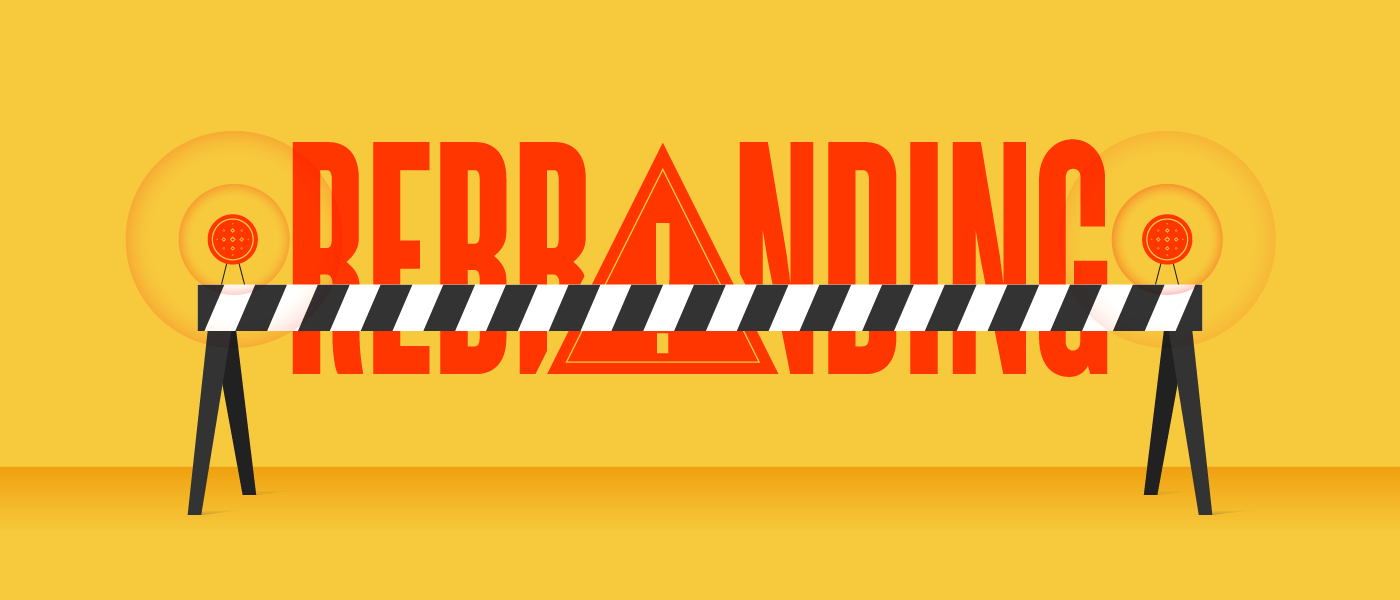A successful rebrand is a tricky thing. Do it well, and you set your brand up for a successful future. Do it poorly, and you become a punchline on the Internet. (RIP to the infamous Gap logo that lasted exactly a week.) While many people find a rebrand mishap to be entertaining, we know what a tragedy it is. The cost of a rebrand is hefty in time, money, and energy, so when it doesn’t work, it’s everyone’s loss. Unfortunately, it’s easy for these types of projects to go off the rails. No matter how prepared you think you are, there are plenty of pitfalls, both small and big, that can sabotage your rebrand—without you even realizing it. We don’t want a bad rebrand to happen to a good company, so today we’re sharing the most common rebrand mistakes (and our best rebrand tips) to avoid them.

10 Rebrand Tips to Avoid the Most Common Rebrand Mistakes
It doesn’t matter if you’re a global brand or a small startup; everyone is vulnerable to rookie mistakes. If you want to succeed in your rebrand—and save your sanity along the way—it’s important to know what to avoid.
Luckily, we’ve seen enough to know what will derail a rebrand (and we’ve made plenty mistakes ourselves). So, to make sure you don’t run into the same trouble, we’re sharing the ten most common pitfalls that can wreak havoc on your rebrand, plus our tips to avoid them. If you’re about to embark on a rebrand, you’ll want to read through these before you call your first meeting.
Mistake 1: Doing a Rebrand Because You Feel Like It
There’s no expiration date on your brand, but sometimes brands feel like they need a change for arbitrary reasons: it’s been too long, their competitor just rebranded, the new CEO doesn’t like the logo, etc. But a rebrand is a huge endeavor that requires serious thought before you begin.
There certainly are valid reasons to pursue one. Some of those reasons:
- You look like everybody else in your industry.
- You’re going after a new audience.
- Your brand has expanded.
- Your brand is painfully outdated.
- Your branding doesn’t reflect your values/identity.
- You’ve dealt with bad press.
- You’ve merged or acquired.
(For more detail on these, check out our top 7 reasons to rebrand.)
Tip: If you think you’re ready, have a serious conversation before you give it a green light. During that conversation you should be able to clearly justify why you’re doing a rebrand and how it relates to your brand strategy.
Mistake 2: Not Knowing Who You Are
When a brand doesn’t have a clear Brand Heart (purpose, vision, mission, and values), it’s hard to complete a successful rebrand. You Brand Heart is your core essence; it influences everything from the products you design to the way you talk to customers.
If you don’t know who you are or why you exist, how can you build a strong brand? How can you effectively communicate? How can you rebrand the right way? It’s nearly impossible.
Tip: Before you start a rebrand, take time to identify and articulate your Brand Heart, including your:
- Purpose: Why do you exist?
- Vision: What future do you want to help create?
- Mission: How do you create that future?
- Values: Who are you? How do you work?
Doing this will help everyone on your rebrand team ensure their work is aligned. If you haven’t done this before, download our Brand Heart workbook to articulate each element.
Mistake 3: Only Changing Your Logo
A logo change is usually the one thing that people are most excited about, as it’s often the big “reveal” for a rebrand. But this is one of the biggest misconceptions about branding. Your brand is not just your logo or visual identity. It is your strategy, your messaging, and more.
If you’re just focused on your logo, you’re missing the point of a rebrand: to reshape your entire brand identity.
Tip: Find out how to build a strong and memorable brand identity the right way, use our visual identity checklist to make sure your team is equipped to create content across mediums, and try our simple process to design a logo you love.
Mistake 4: Not Doing Enough Research
Before you pull the trigger on a rebrand, it’s important to know:
- How your brand is currently perceived (internally and externally)
- How your competitors are perceived
The more you understand where you’re at and where you need to go, the more likely your rebrand will set you up for success.
Tip: To explore your competitors, complete a competitive analysis. This will help you assess how they approach all aspects of their branding, from logo design and tagline to brand voice and messaging.
To find out how employees feel about your brand, follow our guide to conduct a brand audit.
To find out how your customers perceive your brand, survey both happy and unhappy customers.
Mistake 5: Writing a Weak Creative Brief
A rebrand is like any creative project. While it sounds fun to just “go nuts,” you need some parameters and guidelines. That’s what a strong creative brief provides. However, it’s important to find the right balance. You don’t want to give your team too little or too much information.
Tip: If you’ve done your brand audit survey (per step 4), you should have all the relevant info you need to write your creative brief. This will help everyone from project managers to designers stay on the same page.
Mistake 6: Not Getting Approval
There’s nothing that will drive your team crazier (and waste time and resources) than an inefficient process. Unless your team loves doing work over at the last minute, one of the biggest things that will help your rebrand go smoothly is getting proper approval at each stage of the process.
Tip: Remember that there are many elements of a rebrand, each of which need sign-off from relevant stakeholders. As you craft your timeline, make sure to build in ample time to get those approvals.
Mistake 7: Copying Trends
Your brand wants to be a leader in its industry, not a follower. So why copy the latest design trends? At best, it looks reductive. At worst, it seems desperate.
For example, as type designer James Edmonson of Oh No Type Co points out, the tech industry has become particularly homogeneous.
EVERYBODY FALL IN LINE! pic.twitter.com/B9JU5nvpMu
— OH no Type Co (@OHnoTypeCo) February 13, 2018
Tip: Having done your competitive analysis, you should have a sense of how you can differentiate yourself from your competitors. Have a discussion about what you do and don’t want to emulate. Note: This doesn’t mean you can’t evolve and elevate your aesthetic, but remember that chasing after trends can result in a boring and indistinct brand.
Mistake 8: Not Future-Proofing Your Identity
You aren’t just rebranding for today; you’re rebranding to help your brand grow into the future. As such, you need to build an identity, particularly a visual identity, that is flexible.
Tip: Consider the different types of content you will need to create. Think about how your logo will look in 10 years, or how technology and platforms will evolve. If you can think critically and anticipate these needs, you will set yourself up for success.
Mistake 9: Not Testing
No matter how beautiful your logo, if it doesn’t connect, it won’t help you achieve your brand goals. (Remember that after Tropicana’s 2009 rebrand, customers were so unimpressed that the brand’s sales fell 20%.)
That’s why audience testing is the key to finding out if your brand identity works. (It can also provide clarity. For example, if you’re stuck between two logo versions, testing can help you decide.)
Tip: The most important questions to ask:
- Does your rebrand resonate with people?
- Does it accurately reflect who you are, what you’re about, and what you’re trying to achieve?
If you test it and there is a significant disconnect between what you’re trying to communicate and what people perceive, you have some more work to do.
Mistake 10: Not Applying It Correctly
After putting so much work into a rebrand—the resources, the testing, the time—there’s nothing worse than letting it go to waste by not teaching people how to use it. (It’s basically tripping right before the finish line.)
Tip: To keep your team is on the same page, learn how to create a brand style guide that’s easy to use. Also, make sure to include clear directions and real-world examples.
How to Create a Stronger Brand Identity
Doing a proper rebrand takes a lot of deep thought and skill. But there are ways to make your team’s life easier with a few tips, tricks, and resources. If you’re ready to go full steam ahead with your rebrand, here are a few posts that might help your team:
- Follow our step-by-step guide to do a rebrand in 10 steps.
- Get inspired by these 25 examples of brands that rebranded the right way.
- Bookmark these 100+ tools to build a brand identity.
Above all, don’t rush. To get the best results, take a methodical approach and keep your team aligned as you work through every stage. But if you need a little extra help, let’s talk. We’d love to help you bring your brand to life.





